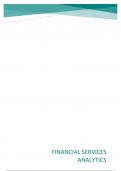FINANCIAL SERVICES
ANALYTICS
, PART 1: GENERAL TECHNIQUE FOR
TRANSFORMING DATA INTO ACTIONABLE
Page | 1 INSIGHTS
1. INTRODUCTION
1.1 INTRODUCTION TO THE COURSE
Goal = business value extraction from data for financial applications
Economic value of data:
1.2 THE RISE OF ANALYTICS IN THE FINANCIAL SERVICES SECTOR
Physical → Digital → Phygital
Why the trend to digitalization?
- Technology has changed
More communication on a digital advice leads to more data to store and process. Because of this
more and more decisions can be data-driven and automated
- Customers have changed
They are more demanding in terms of user experience, require personalization and low costs.
They embrace digitalization: they have a high trust in information technology firms, they interact
with an increasing number of digital devices, they accept that user data is used for corporate
purposes, and they accept to interact with robots.
- Regulation has changed
Payment Services EU Directive = PSD2
→ Banks are required to provide access to payments accounts for Third Party Providers (TPPs) on
the condition that the TPP has received permission from the bank customers to whom the
accounts belong.
- Bank’s profitability is under pressure
Return on equity below the cost of capital is unsustainable in the long run.
- Competition has increased
New entrants that specialize in 1 service. Ex. Apple Pay, Google Pay, …
- Covid-19
Drop in use of cash, no physical contact with bank
,Deloitte paper → Banks that digitalized early on deliver the
best user experience in account opening, transfers and buying a
credit product
Hurdles in the transformation:
- Cost of the transformation (IT, data, new staff)
Cost of digitalization = hardware, software, data, skilled Page | 2
people
=K+M*n
= Fixed cost + Marginal cost (variable cost) * number of users
For digitalization fixed costs are high. Ex. of fixed costs are security, …
What matters for profitability is the average cost per user:
𝐾
Average cost per user = + 𝑀
𝑛
The more users the lower the average cost per user ➔ Advantage for big banks with many users,
since the cost per user is lower.
- People: war for talent
People who can make the data tell its story are in high demand
- Technology: Fast evolving
Staying up to date is challenging (cost, people, vision)
- Vision: Proactivity and persistence, as it takes time
C-suite at banks have a chief digital officer, chief information officer, chief data officer.
Consequence: Banks are becoming very good at providing digital service and look beyond the services of a
bank. For example, KBC wishes to become the Bol.com of services.
1.3 INTRODUCTION TO R
Environment: shows existing objects
File > New File > R-script: to save the code to use it later
Use # to add comments
Object
→ In R everything is an object
→ Assign the value using a left arrow “<- “
Data types
→ Character = text
→ Numeric = numbers
→ Boolean = TRUE or FALSE
Data structures
→ Vector: created using c()
→ Data frame: created using data.frame()
→ Matrix: created using matrix(), the first argument is the vector you want changed into a vector, the
second argument is the number of columns (ncol = …)
Selection of elements
→ To select an object in a vector or data frame we use [], when selecting objects in a matrix use [, ]
the first number is the row and the second the column
, 2. FROM DATA TO INSIGHTS
We have an abundance of data.
R has data available in the program. We can access it through R commands.
What we observe on day t: DATAt
Page | 3 What we assume: DATAt = SIGNALt + NOISEt
What we want to know: SIGNALt
The signal gives us actionable insights on day t. The signal needed depends on the insights one wants to
get.
How?
The price data themselves need to be transformed to yield insights.
Ex.: - Smoothening the price data by taking averages
- Studying financial risk and reward by computing returns
- Time series aggregation: from individual trades (intraday) to daily, weekly, … observations
These transformations are done repeatedly and are best programmed as functions.
2.1 FUNCTIONS IN R
General syntax of a function:
A function has a number of arguments and using
these the functions will do a calculation.
Functions are just like data objects in R. The advantage of functions is that they contain reusable code:
reduces workload, helps to avoid errors.
Ex. Function that computes the square
Power 2 <- function ( x ) {
out <- x^2
return (out)
}
= function definition
To use the function: power2 (3)
The advantage of a statistical software environment like R is most of the functions already exist. Functions
in R are shared through packages:
- Base packages are automatically installed when you install R. They are loaded automatically every
time you open R.
o Statistical functions: mean(), min(), max(), median(), sd(), IQR() = 3rd quartile – 1st quartile,
summary()
o Graphical tools: plot(), hist(), qqplot(), boxplot(), …
o Object handling functions: read.table(), read.csv(), readRDS(), save.RDS(), write.csv(), …
o Probability functions: rnorm(), pnorm(), qnorm(), rt(), qt(), …
- Other packages need to be installed and need to be loaded. → library (“name of package”) Ex.
quantmod: useful for quantitative modelling
In R: “?name of function” → gives you an explanation of the function
To save the data, define a working directory and the results will be saved there.




